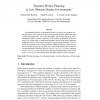Free Online Productivity Tools
i2Speak
i2Symbol
i2OCR
iTex2Img
iWeb2Print
iWeb2Shot
i2Type
iPdf2Split
iPdf2Merge
i2Bopomofo
i2Arabic
i2Style
i2Image
i2PDF
iLatex2Rtf
Sci2ools
WADS
1997
Springer
1997
Springer
Dynamic Motion Planning in Low Obstacle Density Environments
A fundamental task for an autonomous robot is to plan its own motions. Exact approaches to the solution of this motion planning problem suffer from high worst-case running times. The weak and realistic low obstacle density (L.O.D.) assumption results in linear complexity in the number of obstacles of the free space [11]. In this paper we address the dynamic version of the motion planning problem in which a robot moves among moving polygonal obstacles. The obstacles are assumed to move along constant complexity polylines, and to respect the low density property at any given time. We will show that in this situation a cell decomposition of the free space of size O
n2
n
log 2 n
can be computed in O
n2
n
log 2 n
time. The dynamic motion planning problem is then solved in O
n2
n
log 3 n
time. We also show that these results are close to optimal.
Related Content
| Added | 08 Aug 2010 |
| Updated | 08 Aug 2010 |
| Type | Conference |
| Year | 1997 |
| Where | WADS |
| Authors | Robert-Paul Berretty, Mark H. Overmars, A. Frank van der Stappen |
Comments (0)

